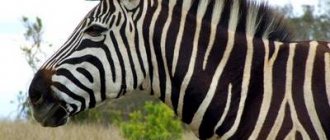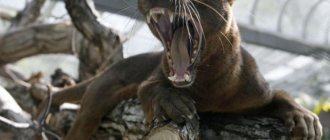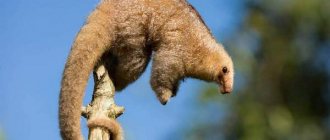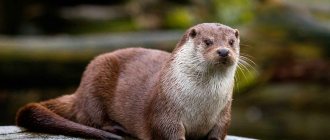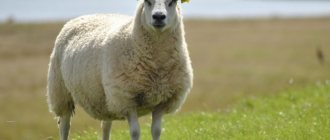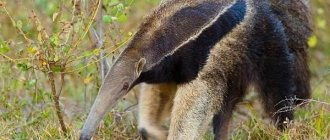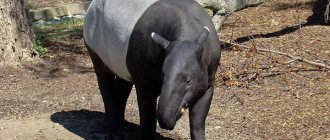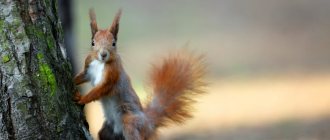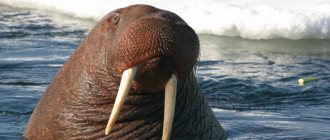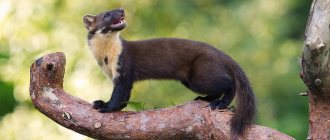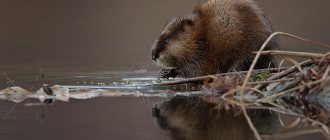Livestock » Sheep
0
2215
Article rating
Kira Stoletova
Mouflon is one of the oldest representatives of the animal world. These artiodactyls are considered the ancestors of the domestic sheep. Even those who have never seen a wild ram can recognize it by its characteristic rounded horns.
Characteristics of the Mouflon mountain sheep
Wild mouflons are distributed throughout Eurasia, but due to the unusual structure of their horns and valuable fur coat, they are hunted in many countries. The extermination of the animal population by humans has led to the fact that some Mouflon breeds are placed in the Red Book. Today, such animals are kept in nature reserves and zoos, and in some countries they are bred at home.
Description and features
Mouflons are ruminants belonging to the artiodactyls. They are relatives and progenitors of domestic sheep and rams. Outwardly, mouflon resembles the above-mentioned relatives, but at the same time has a number of distinctive features and characteristics.
So, the size of this animal may be smaller than that of a domestic sheep, no more than one meter in height and width, weighing about fifty kilograms. Mouflons have a small head and slightly elongated neck.
The ears are small and the dark brown eyes are slightly bulging. The body of the animal is slender and graceful, the hair is most often short. The legs are long and thin, but at the same time very strong and strong. The tail is quite short.
The body color of mouflons, both females and males, is approximately the same: brown shades predominate, the fur on the chest is darker and thicker (in these places it can grow in the form of a frill), the legs are covered with white and black hair, and the belly is also white.
The main feature of mouflons is their massive horns, which are especially valued by hunters. The horns of these animals are large and can reach up to 75 centimeters in length. They are round in shape and pointed at the ends. The horns can curl backwards or to the sides. Females either do not have horns or they are weakly expressed.
An interesting fact is that the difference between the weight of females and males is achieved precisely due to the presence of such voluminous and weighty horns in the male sex, which can add about ten to fifteen kilograms to them.
Recommendations
- ^ a b c d
Michel, S. & Ghoddousi, A. (2020).
" Ovis gmelini
".
IUCN Red List of Threatened Species
.
2020
: e.T54940218A22147055. - Hiendleder, S.; Kaupe, B.; Wassmuth, R.; Jahnke, A. (2002). "Molecular analysis of wild and domestic sheep challenges current nomenclature and provides evidence of domestication from two different subspecies." Proceedings: Biological Sciences.
.
269
(1494):893–904. Doi:10.1098/rspb.2002.1975. PMC 1690972. PMID 12028771. - ^ a b
Hiendleder, S.;
Mainz, K.; Plante, Y.; Lewalski, H. (1998). "Mitochondrial DNA analysis shows that domestic sheep are descended from two different ancestral maternal sources: there is no evidence for a contribution from urial sheep and argali." Journal of Heredity
.
89
(2): 113–120. Doi:10.1093/jhered/89.2.113. PMID 9542158. - ^ a b
Blyth, E. (1841).
"Updated list of species of the genus Ovis
."
Annals and Journal of Natural History;
Zoology, Botany and Geology .
7
(44): 248–261. - IUCN Specialist Group/SSC Caprinae (2000). Caprinae Taxonomy Workshop, May 8–10, 2000
. Ankara, Türkiye: IUCN. - Nasonov, N.V. (1909). "Note preliminaire sur une nouvelle espèce de Mouton sauvage, Ovis laristanica
, de la Persie méridionale" (PDF).
News of the Imperial Academy of Sciences
.
VI. 3
(18): 1179–1180. - Nasonov, N.V. (1910). “About the wild eastern sheep of S. Gmelin ( Ovis eastern
Poll.)” [About the wild eastern rams
C. gmelina
(
Ovis eastern
Poll.)] (PDF).
Proceedings of the Imperial Academy of Sciences
.
VI. 4
(9): 681–710. - MacDonald, D.; Barrett, P. (1993). Mammals of Britain and Europe
.
1
. London: HarperCollins. pp. 220–221. ISBN 978-0-00-219779-3. - Vigne, J. D. (1994). "Les transferts anciens de mammifères en Europe occidentale: histoires, mécanismes et impations dans les Sciences de l'homme et les Sciences de la vie." Colloques d'Histoire des Sciences zoologiques
.
5
: 15–37. - ^ a b
Bouquet, Wu, Zhang, Wang (2005).
"Phylogenetic analysis of bighorn sheep ( Ovis nivicola
) and closely related taxa,"
Journal of Heredity
, 97(1) 21–30. [1] - Loi, P.; Ptak, G.; Barboni, B.; Fulka Jr, J.; Cappai, P.; Clinton, M. (2001). "Genetic rescue of an endangered mammal by interspecies nuclear transfer using postmortem somatic cells." The Nature of Biotechnology
.
19
(10): 962–964. Doi:10.1038/nbt1001-962. PMID 11581663. S2CID 10633589. - Trivedi, B. P. (2001). "Scientists clone first endangered species: wild sheep." National Geographic today. Retrieved February 21, 2006.
- Winstead, E. (2001). “Endangered wild sheep clone found healthy.” Genome News Network. Retrieved April 10, 2007.
- Blyth, E.; Owen, R. (1840). "On the species of the genus Ovis
."
Proceedings of the Zoological Society of London
.
8
: 62–79.
Types of mouflons
There are different types of mouflons, depending on their habitat. The following types are distinguished:
- European mouflon - lives in Europe and looks as described above.
- Transcaucasian mouflon - this species is slightly larger than the European one, but in appearance it is almost no different.
- Crimean mouflons are a variety of European mouflons that were brought to the territory of Crimea more than a hundred years ago and managed to take root here.
- Asian mouflon or arcal - this species is no different from the European one, except for a different habitat and larger size.
- Ustyurt mouflon is a variety of Asian mouflon that lives in the steppes of Kazakhstan.
- Armenian mouflon differs from typical representatives by the presence of dense vegetation on the face.
- Corsican mouflon is a variety of European mouflon native to the island of Corsica.
As you can see, all types of mouflons have approximately the same anatomical structure, but due to their different habitats they have different names.
Animal domestication
1. Name the animals that were the first to be domesticated by humans.
Dog, reindeer, later – goat, sheep, pig, cow.
2. How did domestication occur in ancient times?
More often by force, when a wild animal was left on a leash, or the female was killed and her cub was taken away.
3. How can domestication occur now?
Breeding and selection - breeding breeds by selecting the characteristics necessary for humans.
In the direction of what characteristics is selection carried out during breeding:
- In birds: egg production, rapid growth;
- In sheep: to increase the number of lambs, to increase body weight, for fleece or for milk;
- In cattle: for milk production, body weight and early maturity.
Lifestyle and habitat
Sheep are predominantly mountain animals, so finding out where mouflons live is not difficult. Animals are attracted to life in mountainous landscapes and steppes, but they are not able to live on steep cliffs and areas riddled with cracks and faults, as mountain goats do.
The habitat of these animals is quite small. Mouflons unite in herds of about 100 individuals, mainly consisting of females, small lambs and a few raised young animals.
Males prefer to live alone and join the general herd only during the rut for several months. As mentioned above, the habitat of mouflons is quite small. This is due to a number of reasons, such as:
- The presence of poachers who exterminate animals for their valuable horns, wool and meat.
- Inability to live in mountain gorges and on the mountains themselves.
- The occurrence of steppe and forest fires, due to which the herd is forced to move to other territories.
- Presence of predators and potential enemies that can reduce the mouflon population.
Mouflons live in both Europe and Asia. The European species mainly inhabits islands such as Cyprus, Corsica, Sicily, Sardinia and Crimea. Here these animals are respected and have been mentioned in various works of art since ancient times. In Asia, some species are found in Armenia and Iraq, but the majority of individuals live in Kazakhstan, Turkmenistan, Tajikistan and Turkey.
It is also worth noting that mouflons are predominantly nomadic animals - they are constantly on the move, in search of a better place to live. Sometimes they can stay in one place for no more than a couple of days and then continue their journey.
Due to the sharp decrease in the number of these animals, they are now under special protection in nature reserves and sanctuaries, where people create special conditions for the restoration of their population.
Behavior
Mouflons are shy animals. They go out for food in the evening or early in the morning. They also won't stay in one place for long.
During the day they rest under overhanging bushes or rocks, choosing a safe shelter that protects them from predators.
Mouflons spend their time moving and grazing in non-territorial herds. They have a highly developed herding instinct and gather in large groups of up to 1000 or more individuals. Can establish close personal connections. They experience stress if they are separated, search, call and hit the ground with their hoofs.
Nutrition
Mouflons are herbivores, so they can find food in almost any area without making much effort. However, in this matter there are certain features associated with the time of year and the area in which the animals are located.
In winter, the diet of wild mouflons is quite poor. During this period, these animals feed exclusively on vegetation growing above the snow cover. For example, this could be moss, lichens, bush tops or tall grass. This is due to the fact that due to their thin legs, mouflons cannot dig through the snow in search of food, like other sheep.
At other times of the year, the diet expands. So in the summer they eat various types of grasses, milkweed, shoots of plants and shrubs, tree leaves and flower petals, as well as summer berries, such as blueberries.
In autumn, various nuts, acorns, mushrooms, bulbs, roots, and cereal plants are added to the above foods. Mouflons, in addition to regular fresh water, are very fond of drinking salt water, which is not typical for other sheep.
They have an interesting feature: unlike other representatives of the sheep genus, mouflons have a different arrangement of incisors, which are responsible for biting off vegetation. Thanks to this special location, they can eat plants to the very roots, as well as dig them up.
Mouflons also graze mainly in the dark. They go out into the meadows at sunset, graze all night and return to their shelters and shelters at dawn. This helps animals avoid unnecessary competitors in search of food and avoid encounters with daytime predators.
Wild sheep diet
Mouflons are herbivores, so the main part of their diet consists of cereals and forbs. The animal is often found in crop fields, thereby damaging the crop.
The normal diet of an artiodactyl consists of the following components:
- green food: feather grass, wheatgrass, sedge;
- shrubs and young trees;
- mushrooms and berries;
- moss, lichen.
In winter, artiodactyls extract plant roots from under the snow. Wormy berries and carrion are valued by herbivores because they supply the Mouflon body with necessary proteins.
Reproduction and lifespan
As mentioned above, male mountain mouflons prefer to live separately and are rarely with the herd. However, during the mating season, which lasts several months, the situation changes dramatically.
From a physiological point of view, mouflons mature at approximately the same time, when they turn two years old. However, this does not mean that two-year-old males can immediately mate with a female - this will not be allowed by older individuals who also want to mate with a potential “bride”. Therefore, only by the age of three or four years, when the mouflon gains enough strength and mass, does he have the opportunity to compete for the right to enter into the mating season with the female he likes.
So, with the onset of autumn, the males begin to return to the herd for the rut. But here a rather complex process is already taking place - males organize real tournaments in order to decide who is worthy of possessing this or that female.
This happens as follows: mouflons, being at a great distance from each other, begin to intimidate their opponent, bleating loudly and digging the ground with their hooves. Then they pick up speed and collide with their horns in a loud scream.
The sound of the impact is deafening. The one who loses consciousness due to the collision is considered the loser. Unfortunately, there have been cases when the blow was so strong that the animal’s cervical vertebrae were broken and it died.
Pregnancy in mouflons lasts only five months, and females can give birth to two lambs at a time, which is a large number and unusual for other rams. Throughout pregnancy, females remain in the herd under constant guard. When the time comes to give birth, they separate from the herd and find a quiet and secluded place where a cub or two is born.
A newborn lamb has enough strength to immediately stand on its feet, and after a while run after its mother. For several weeks, mother and child follow their herd, without approaching other individuals.
This is necessary so that the baby gets stronger and gains strength. During reunification with the herd, the mother carefully hides the child from older males, since they can behave very aggressively with lambs.
The lifespan of mouflons may vary depending on their habitat. Thus, in the wild they can live up to ten years, and in nature reserves and sanctuaries, with good maintenance and the absence of stress factors, up to fifteen to seventeen years.
Natural enemies
Mouflon is extremely sensitive thanks to excellent hearing, good eyesight and a keen sense of smell (the sense of smell in representatives of the species is more developed than other senses). The most fearful and cautious are females with cubs.
Interesting. Guard duty in the herd is performed not only by the leader, but also by the rest of the adult males, who periodically replace each other.
When threatened, the sentry makes a sound like “cue...k.” Something similar to “tokh-tokh” is heard when rams, led by a leader, run away from danger. Females with lambs run behind him, and the old males bring up the rear of the herd, who occasionally stop and look around.
Terrestrial predators are recognized as natural enemies of mouflon:
- wolf;
- lynx;
- wolverine;
- leopard;
- fox (especially for young animals).
Eyewitnesses claim that from the leeward side you cannot approach the mouflon closer than 300 steps. Even without seeing people, the animal can smell them 300–400 steps away. Driven by curiosity, the mouflon sometimes allows a person to approach 200 steps if he does not show aggression and behaves calmly.
Return to content
Interesting Facts
Mouflons are unique animals, so there are a huge number of interesting and unusual facts about them. Unfortunately, among them there are also happy and sad ones.
- Mouflon horns are of great value all over the world, so poachers have recently destroyed about thirty percent of the total animal population. And all this for the sake of horns, which are used as trophies. Also, the skin and meat of this animal are no less valuable.
- Mouflons are listed in the World Red Book and are protected by nature reserves and wildlife sanctuaries.
- Female mouflons are capable of reproduction at the age of one and a half to two years and bear offspring for no more than five months. This period is a record for all representatives of the sheep genus and allows mouflon to restore the number of individuals at a fairly fast pace.
- Several decades ago, scientists believed that the best way to preserve the mouflon population was cloning. So, they conducted an experiment, as a result of which an artificially conceived and raised lamb was born, which lived for about seven months. This method of preserving mouflons and increasing their numbers causes a large number of scientific and ethical disputes among people of different generations.
- Mouflons are the only sheep that do not shed their horns.
- In Cyprus, images of mouflons are minted on coins.
- Sometimes a person who is capable of irritating the people around him with his behavior is called a mouflon. However, this nickname is absolutely not associated with these representatives of the ram family.
Taxonomy
Ovis gmelini
was the scientific name proposed by Edward Blyth in 1841 for wild sheep in the Middle East.[4] Several wild sheep were described in the 19th and 20th centuries and are considered mouflons. subspecies today:[5]
- Ovis ophion
Blyth in 1841 for wild sheep in Cyprus;[4] - Ovis laristanica
by Nikolai Nasonov in 1909 on wild sheep in Lar in southern Iran;[6] - Ovis orientalis isphahanica
Nasonov in 1910 for wild sheep in the Zagros Mountains.[7]
Care and maintenance of mouflons at home
Recently, keeping sheep on farms, personal households and plots of land has become quite popular. People breed mouflons to improve their economically important qualities and breed more hardy offspring.
However, unlike other rams, mouflons have a number of specific requirements, the compliance with which determines the possibility of keeping these animals at home. Since on farms they can only be kept in enclosures, the following points must be taken into account when arranging them:
- Mouflon nutrition (you need to know what and how much these animals eat);
- The absence of potential enemies and predators that could threaten the safety of the herd;
- Possibility of movement of animals, that is, the area of the enclosure should not be less than several hectares (fifteen individuals need one hectare of land);
- The possibility of reproducing offspring, that is, in a herd there should be one male for every three or four females capable of bearing offspring.
Also in the enclosure itself should be present:
- Permanent feeders filled with food for mouflons;
- Facilities for conducting veterinary activities and examinations;
- Facilities for permanent water supply or artificial reservoirs;
- Feeders with hay;
- Objects with brackish licks;
- Structures under which mouflons can shelter from bad weather.
The enclosures themselves should be on dry and rocky soil so that the animals can feel comfortable. The use of barbed wire to create fences is unacceptable, as mouflons can be injured by it. This is the minimum set of conditions under which mouflons can live peacefully at home.
Health
With good nutrition and favorable conditions, mouflons are highly resistant to various diseases.
The most common diseases that cause the greatest harm to animal health and often reduce livestock include:
- Fascioliasis, which is an acute or chronic inflammation of the liver and bile ducts. Inflammation is caused by trematodes, Fascilla vulgaris or Fascilla giganta. Parasites enter the animal's body along with water or food that grows in lowlands with high dampness. The peak of the disease occurs in the summer. A sick animal becomes lethargic, apathetic, and loses its appetite. In lactating females, the milk becomes thin, causing the lambs to lack nutrition and fall behind the herd.
- Moniesiosis. This type of disease is most often observed in young animals under the age of 1.5 years. The causative agent of the disease is the tapeworm Moniezia expansa, which affects the small intestine. Mouflons affected by the parasite experience developmental delays and decreased immunity. In addition, their risk of developing secondary diseases and infections increases.
- Echinococcosis. It is the result of the ingestion of the helminth Echinococcus granulosus, which mainly affects the tissues of the liver and lungs. Damage leads to functional impairment of organs and their atrophy. Signs of the disease include indigestion, shortness of breath, and cough.
- Among infectious diseases, the greatest danger for sheep is bradzot, which is characterized by rapid intoxication of the entire body with damage to internal organs.
